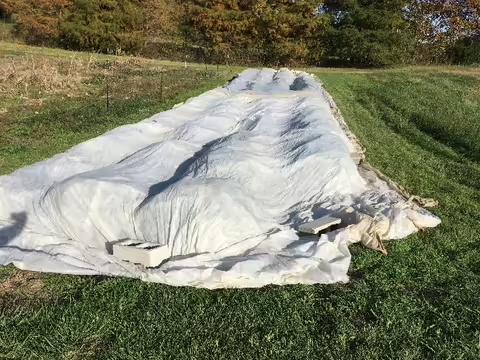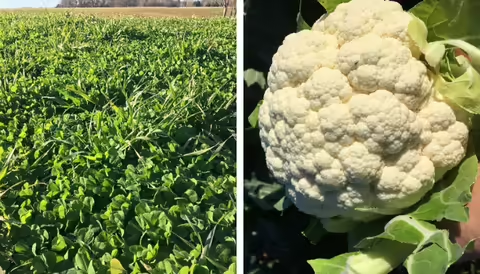St. Louis Metro East Regional Report
Harvest is completed for all but horseradish. Apple and cider sales remain strong. Temperatures have been all over, from dropping into the low 30’s several nights to working back up into the 60s overnight. The last week has been rather breezy, knocking off much of the remaining leaves, especially when combined with rain. Temperatures are expected to drop in the low 20’s next week, so preparation to cover strawberries will be a priority for some. Weather has been good for orchards to pull and plant trees. Temperatures have been good for root growth of fall-planted garlic. Tomato, pepper and cucurbit vines have been withered by a few light frosts, so field sanitation is ongoing. Sanitation is also critical for bitter rot and scab control in apples. At the end of the growing season, all fallen or hanging fruit should be collected and destroyed to reduce bitter rot inoculum. Scab overwinters on leaves so sanitation should focus on speeding the decomposition of the leaves so the pathogen cannot survive. This can be accomplished with a urea spray as close to leaf fall as possible and/or by flail mowing the orchard floor. For a urea spray, use the rate of 40lbs feed grade urea/100 gallons water and apply at 100 gallons/acre. Research supports this low rate benefit trees and does not delay the onset of dormancy. Feed grade urea is recommended because it dissolves more readily, compared to fertilizer grade, but fertilizer grade will do the job too. Consider pre-dissolving the urea in hot water (5-gal bucket) before adding to the tank. If the window to spray the canopy has been missed, the urea solution can be applied to leaves on the orchard floor.
Elizabeth Wahle (618-344-4230; wahle@illinois.edu)
Southwestern Illinois (Waterloo) Regional Report
Overall most of November has been fairly typical weather overall. I would say we might be on average just a little cooler than normal but have had some more mild days that have countered a few cooler ones. Precipitation has been fairly limited and soil conditions are still on the dry side of normal. The last few systems that have passed this month
have brough little if any rain; usually not more than a tenth or two at most. This has been good for fall field work and clean up. The growing season came to an end the first few days of November with our first frost and most and morning lows between 30-32° on the 11/1-3. This is a few weeks later than average this year and many fall crops appreciated the extended time to grow. The coldest morning so far we have had has been the morning of 11/23 when we had 24°. Otherwise we have mainly been in the 50s for highs with some days a little warmer or cooler. We have had a nice amount of sunshine most days which has been nice no matter the temperature.
Out in the field, things have slowed down but some more cold hardy, fall crops still are doing well. At home I have some later plantings of lettuce, spinach, and turnips that I have put under a low tunnel and row cover. They are still fairly small, but there might be some spinach coming in a week or two if the weather doesn’t get too cold. I also have finished up the harvest of all of the primary heads of broccoli in my fall planting and now have moved on to harvesting side shoots. Although smaller in size, the quality is just as good as the first head. I plant my broccoli further apart than most, close to 24 inches; this makes for some fairly large heads. Some heads are close to 2 lb, but still very tender. With this wider spacing, even some side shoots are almost the size of a “normal” head of broccoli. This spacing isn’t the typical 12-18 inches, but it works for us. Certainly, it helps distinguish our crop from that of what you find in the stores. I’m still (patiently) waiting on my cauliflower. It has some small head maybe 3” or so in diameter. All of the broccoli and cauliflower I covered with row cover early in November. Hopefully that will push growth a little more and protect it from any damage from lower temperatures. The crop quality has been very good and this season we have been able to manage caterpillar pests with Dipel (Bt) very successfully. I haven’t seen any caterpillars at all.
Hope everyone has a great Thanksgiving!
Nathan Johanning (618-939-3434; njohann@illinois.edu)
Southern Illinois (Murphysboro)
We have had several nights of temperatures below freezing and have covered the carrots and greens several times with row covers. We have put down straw mulch to protect some of our perennial herbs, including rosemary, thyme, and oregano.
In the tunnel we have seen signs of mice and other rodents, damaging plants and creating tunnels in the beds. We
have put out bait stations, as well as, trying to remove areas that provide cover for small rodents. Plasticulture strawberries can also be at risk of rodent damage, both to the plants and irrigation under the plastic. You can reduce rodent damage by keeping field edges free of overgrown weeds and other ground cover. Catching the problem early can go a long way to preventing serious damage, so take note of new mounds of dirt, chewed lines, or other signs of activity. If you are planning to use any poison or bait, follow all label instructions and use a bait station.
The Jackson county grounds are mostly put to bed for the winter. The asparagus ferns will be mowed in December or January depending on the condition of the soil. Inside the High Tunnel, we have harvested the tatsoi twice and will be harvesting the other greens and radishes soon. The colored carrot planting is also going strong. There are some noticeable differences in height and vigor between the different varieties.
Fall Plantings at the Jackson County High Tunnel. Photos: K. Bell
As always have a happy and safe fall, and a happy Thanksgiving!
Katie Bell (618-687-1727; klbell@illinois.edu)
Fruit & Vegetable Production and Pest Management
Very Warm and Wet October in Illinois
October in Illinois was much warmer and wetter than average statewide.
Temperatures averaged 60.2°F, 5.4° above the 1991–2020 normal for October. Monthly average temperatures ranged from the high 50s in northern Illinois to the low to mid-60s in southern Illinois. These temperatures were 2° to 7° above normal across most of the state, with the larger departures in northern Illinois. Following a warm start to fall in September, temperatures were consistently 5° to 10° above normal for the first half of October. Nighttime minimum temperatures had the highest departures. The October average minimum temperature (51.1°) was the highest on record statewide.
The highest temperature observed in October was 91° in Congerville in Woodford County, and the lowest temperature was 24° in Galena in Jo Daviess County. The unusually warm October weather broke 13 daily high maximum temperature records and 58 daily high minimum temperature records. No daily low maximum or low minimum temperature records were broken in October.
Precipitation statewide in October was 6.13 inches, 2.87 inches above the long-term statewide average. Following a very dry September for most of the state, the taps opened in October and created persistently soggy conditions. For example, Champaign recorded 19 “wet days” in October, those in which at least 0.01 inches of precipitation are observed, which was the third most on record.
The persistently wet conditions resulted in monthly totals ranging from 3.5 inches in southwest and far southeast Illinois to over 9 inches in parts of north-central Illinois. While southern Illinois was 1 to 3 inches wetter than normal last month, central and northern Illinois were closer to 3 to 6 inches wetter than normal. It was the second wettest October on record in Peoria and Quincy and the fifth wettest in Springfield.
Severe weather reports: The NOAA Storm Prediction Center recorded 55 severe weather reports in October for Illinois: 16 for tornadoes, 4 for hail, and 35 for wind. (Multiple reports can be generated for a single event). As of the end of October, 78 tornadoes were confirmed in Illinois this year, compared to 71 in all of 2020, 37 in 2019, and 64 in 2018.
Drought: Although the October rain put harvest on hiatus, it was greatly beneficial in improving the drought conditions in northern Illinois. Soil moisture and streamflow were both boosted by the wet conditions last month. The U.S. Drought Monitor showed improved drought conditions throughout much of northern Illinois in the most recent month. The percentage of the state in at least severe drought (D2) declined from 8.78% on October 1 to 1.22% on November 2.
Most areas between Whiteside County in northwest Illinois and Lake County in northeast Illinois remain in moderate to severe drought, however, as year-to-date precipitation deficits of 5 to 10 inches remain. Wetter weather will need to prevail throughout the winter to terminate the northern Illinois drought, but October was a big step in the right direction.
Winter Outlook: The end of October also brought the Climate Prediction Center’s sought-after climatological winter (December–February) outlooks. Following a typical La Niña pattern, the outlooks show the highest odds of a warmer and wetter than normal winter across the state.
Trent Ford, Illinois State Climatologist (217-244-1330; twford@illinois.edu
Upcoming Programs
See the University of Illinois Extension Local Food Systems and Small Farms Team’s website at: http://web.extension.illinois.edu/smallfarm/ and the calendar of events at http://web.extension.illinois.edu/units/calendar.cfm?UnitID=629.
-
The Great Lakes Fruit, Vegetable & Farm Market Expo (GLEXPO) is returning to its traditional face-to-face format, and will be held December 7-9, 2021 at the DeVos Place in Grand Rapids, Michigan. Registration for the program itself will be coming at a later date, but you should make your room reservations now as hotels near the conference site tend to fill up quickly. Visit their website for additional details as they become available at https://glexpo.com/expo-schedule/ or visit their Facebook page at https://www.facebook.com/GLExpo/
-
2022 KY Fruit and Vegetable Conference will be held January 2-4, 2022 in Bowling Green, KY. Registration and conference information can be found at https://kyhortcouncil.org/2022-ky-fruit-vegetable-conference/
-
2022 Illinois Specialty Crops Conference, January 5-7, 2022 at the Springfield Crowne Plaza. Attend in-person, view LIVE sessions remotely, or watch workshops at-your-own pace! For more information or to register visit https://www.specialtygrowers.org/iscc2022.
-
Great Plains Grower School (Kansas, Missouri, Nebraska and Iowa) will be held January 7-8, 2022 in St. Joseph, MO. Registration and conference information can be found at https://www.greatplainsgrowersconference.org/
-
Illiana Vegetable Growers Symposium, Wednesday, January 12, 2022, 8:00 a.m. to 4:00 p.m. Central Time, at Teibel’s Family Restaurant, 1775 US 41, US 30 & US 41, Schererville, Indiana. Registration for 2022 is open! Register online before midnight January 4, 2022. Visit https://cvent.me/ZqPo2w . Or, download the registration form, and mail in, postmarked by Dec. 20, 2021. For more information contact Nikky Witkowski, nikky@purdue.edu, 219-465-3555.
-
Indiana Hort Congress, January 19 -29 2022, Marriott Indianapolis East, 7202 East 21st Street, Indianapolis, IN 46219. For more details visit https://www.indianahortconference.org/

